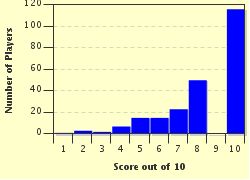Quiz Answer Key and Fun Facts
1. Chimps, gorillas, baboons, lemurs
2. Squirrels, rats, mice
3. Lions and tigers and bears (oh my!)
4. Hedgehogs, true moles, true shrews
5. Duck-billed platypus, spiny anteater
6. Elephants, mastodons, mammoths (but not tapirs)
7. Rhinos, tapirs, zebras
8. Hippos, antelope, deer, giraffes
9. Dugongs, manatees, Steller's sea cow
10. Vampire bats and "flying foxes"
Source: Author
gracious1
This quiz was reviewed by FunTrivia editor
Tizzabelle before going online.
Any errors found in FunTrivia content are routinely corrected through our feedback system.

